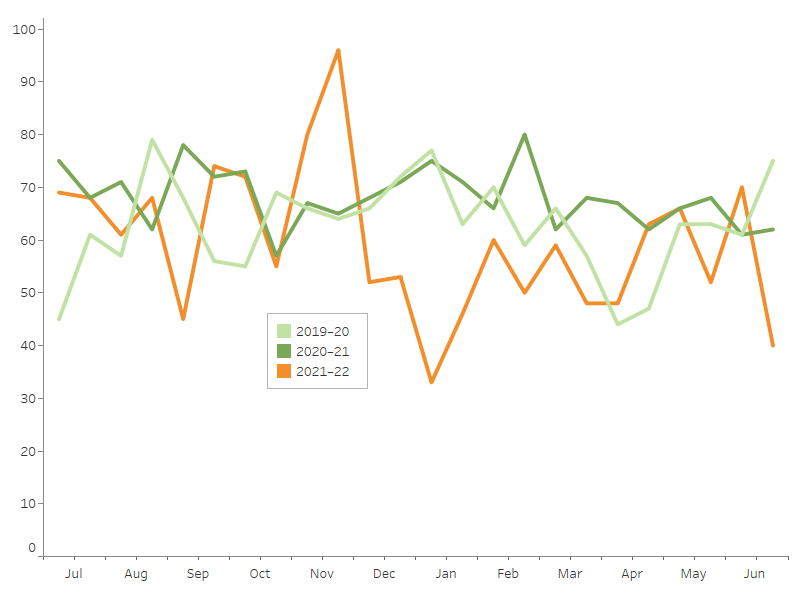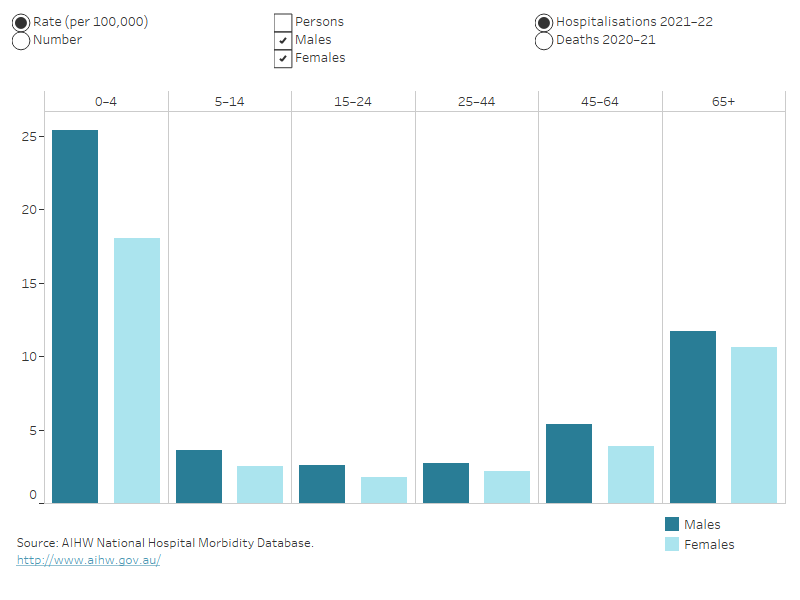For more detail, see Data tables A1-2 and D1–2.
Severity
There are many ways that the severity, or seriousness, of an injury can be measured. Some of the ways to measure the severity of hospitalised injuries are:
- number of days in hospital
- time in an intensive care unit (ICU)
- time on a ventilator
- in-hospital deaths.
Compared to all injury hospitalisations in 2021–22, for choking and suffocation:
- the average duration of a hospital stay was less than half as long
- the percentage of cases that included time in an ICU was about twice as high
- the percentage of cases that involved continuous ventilatory support was about 3 times as high (Table 2)
- the rate of in-hospital deaths was almost 4 times as high.
Table 2: Severity of choking and suffocation injuries, 2021–22 hospitalisations
| |
Choking and suffocation
|
All injuries
|
|
Average number of days in hospital
|
2
|
4.7
|
|
% of cases with time in an ICU
|
4.2
|
2.0
|
|
% of cases involving continuous ventilatory support
|
3.2
|
1.1
|
|
In-hospital deaths (per 1,000 cases)
|
23.4
|
5.9
|
Note: Average number of days in hospital (length of stay) includes admissions that are transfers from 1 hospital to another or transfers from 1 admitted care type to another within the same hospital, except where care involves rehabilitation procedures.
Source: AIHW National Hospital Morbidity Database.
For more detail, see Data tables A12–13.
There were 59 hospitalisations in 2021–22 and 30 deaths in 2020–21 due to choking and suffocation among Aboriginal and Torres Strait Islander people.
For more detail, see Data tables A1–3 and D4–9.
In 2021–22, people living in Outer regional areas had higher age-standardised rates of hospitalisation due to choking and suffocation than people living in less remote areas (Table 3).
Table 3a: Age-standardised rates of hospitalisation (per 100,000) due to choking and suffocation, by remoteness and sex, 2021–22
| |
Males
|
Females
|
Persons
|
|
Major cities
|
5.9
|
4.7
|
5.3
|
|
Inner regional
|
5.8
|
4.1
|
4.9
|
|
Outer regional
|
7.3
|
4.7
|
6.0
|
|
Remote
|
n.p.
|
n.p.
|
n.p.
|
|
Very remote
|
n.p.
|
n.p.
|
n.p.
|
n.p. not published because of small numbers, confidentiality, or other concerns about the quality of the data.
Note: Rates are age-standardised per 100,000 population.
Source: AIHW National Hospital Morbidity Database.
Table 3b: Age-standardised rates of death (per 100,000) due to choking and suffocation, by remoteness and sex, 2020–21
| |
Males
|
Females
|
Persons
|
|
Major cities
|
4.1
|
2.7
|
3.3
|
|
Inner regional
|
4
|
2.5
|
3.2
|
|
Outer regional
|
5
|
2.9
|
3.9
|
|
Remote
|
n.p.
|
n.p.
|
n.p.
|
|
Very remote
|
n.p.
|
n.p.
|
n.p.
|
n.p. not published because of small numbers, confidentiality, or other concerns about the quality of the data.
Note: Rates are age-standardised per 100,000 population.
Source: AIHW National Hospital Morbidity Database.
For more detail, see Data tables A7–A9 and D9–10.
For information on how the statistics were calculated by remoteness, see the technical notes.



 1,500 hospitalisations in 2021–22
1,500 hospitalisations in 2021–22 1,200 deaths in 2020–21
1,200 deaths in 2020–21
